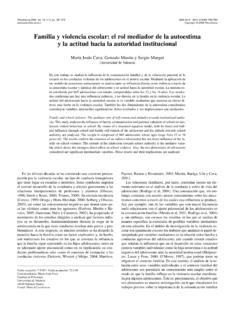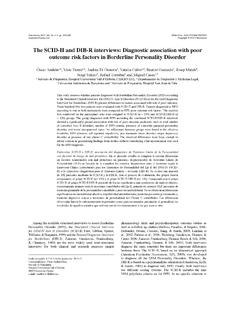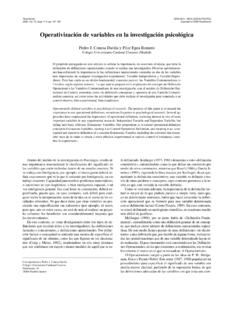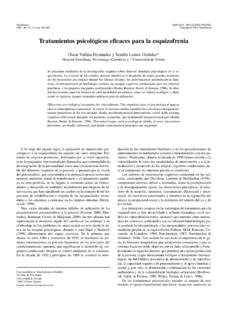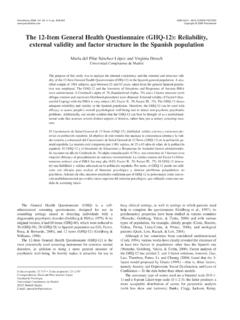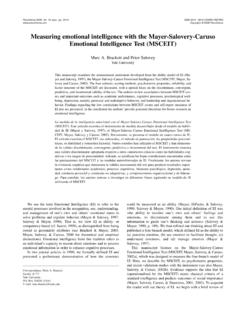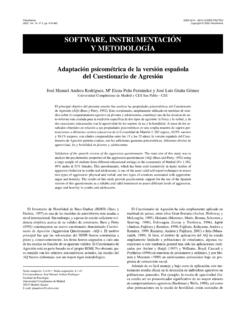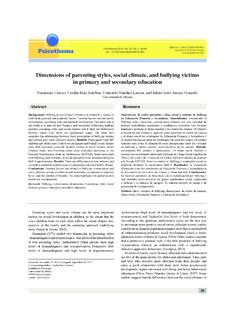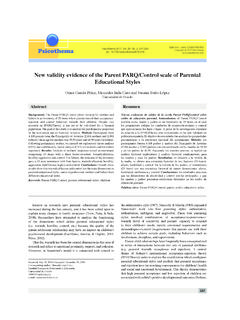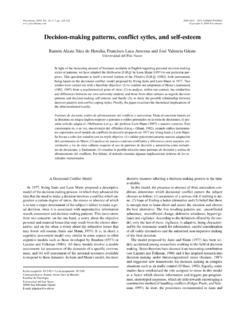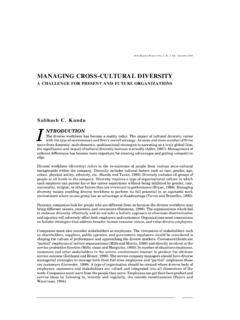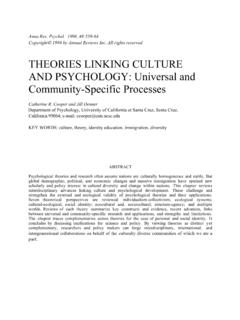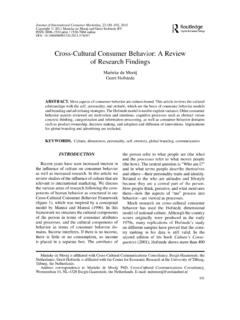Transcription of Hofstede and Schwartz’s models for classifying ...
1 Psicothema ISSN 0214 - 9915 CODEN PSOTEG. 2000. Vol. 12, Supl., pp. 25-33 Copyright 2000 Psicothema Hofstede and schwartz 's models for classifying individualism at the cultural level: their relation to macro-social and macro-economic variables1. Valdiney V. Gouveia and Mar a Ros*. Federal University of Para ba, * Complutense University of Madrid One of the most used dimensions for comparing human values at the cultural level is that of indivi - dualism- collectivism . It was originally proposed by Hofstede (1984), and continues to be employed in current theoretical models such as those of Triandis (1995) and schwartz (1994). Although the Hofstede and schwartz models have been compared in previous studies, there is little data that per- mits an evaluation of their explanatory potential with respect to macro-social and macro-economic va- riables. Furthermore, even when there is evidence to the relation of the individualism - collectivism di- mension with others, such as power distance, autonomy and conservation, they are not usually trea- ted in the same study.
2 In this sense, our work compares these two models in relation to the values of individualism - collectivism . With this goal in mind, the same 20 countries that have scores in Hofste- de and schwartz 's studies on these dimensions are compared in relation to a group of macro-social (birth rate, human development, illiteracy rate, etc.) and macro-economic (gross national product, ra- te of agricultural activity, rate of inflation, etc.) variables. Results show that the Hofstede model is better explained by macro-economic variables while the schwartz model is better accounted for by macro-social variables. Los modelos de Hofstede y de schwartz para clasificar a las naciones en Individualismo-Colecti - vismo: su relaci n con variables macro-sociales y macro-econ micas. El individualismo- colecti- vismo es una de las dimensiones m s utilizadas para comparar a un nivel cultural los valores huma- nos.
3 Fue propuesta originalmente por Hofstede (1984) y continua siendo utilizada en modelos te - ricos contempor neos como los de Triandis (1995) y schwartz (1994). Aunque los modelos de Hofs- tede y schwartz han sido comparados en previos estudios hay poca evidencia que eval e su capaci- dad explicativa en relaci n a variables macro-sociales y macro-econ micas. Mas aun, aunque hay evidencia de la relaci n de la dimensi n de Individualismo-Colectivismo con otros, como la distan - cia de poder, la autonom a y el conservacionismo, estas dimensiones generalmente no se utilizan en el mismo estudio. En este mismo sentido nuestro trabajo comparar los dos modelos ( Hofstede y schwartz ) en relaci n a los valores Indidividualismo-Colectivismo. Para cumplir este objetivo, 20. pa ses que poseen puntuaciones de las dimensiones de Hofstede y schwartz son comparados en re- laci n a un grupo de va ri ables macro-sociales (tasa de natalidad, desarrollo humano, tasa de analfa- betismo, etc.)
4 Y macro-econ micas (producto nacional bruto, tasa de actividad agr cola, tasa de in- flaci n, etc.). Los resultados muestran que el modelo de Hofstede se explica mejor por las variables macro-econ micas, mientras que el modelo de schwartz se explica mejor por las variables macro- sociales. There are various theoretical approaches to the structure of va- grouped under individualism , while those cultures whose most im- lues at the cultural level, such as those employed by Hofstede portant values place emphasis on the dependency of the individual (1984), Triandis (1995) and schwartz (1994). Hofstede proposes a with respect to in-groups are clustered under collectivism . Trian- one dimensional structure called simply individualism -collecti - dis, Bontempo, Villareal, Asai and Lucca (1988) initially began, li- vism; those cultures that emphasize the autonomy of the person are ke Hofstede , with a unidimensional understanding, but recently (Triandis, 1995; Triandis & Gelfand, 1998) have progressed to- ward the recognition of bi-dimensionality.
5 schwartz (1990, 1994), criticizes this dychotomical assignment of values to either indivi- Correspondencia: Mar a Ros dualism or collectivism , and suggests that some values can serve Department of Social Psychology both individual and collective interests. Given that our study focu- Complutense University of Madrid 28023 Madrid (Spain) ses only on the comparison of the Hofstede and schwartz models , E-mail: we will now proceed to explain each one of them. 26 VALDINEY V. GOUVEIA AND MAR A ROS. individualism - collectivism at the Cultural Level: The Hofstede ment versus relationship enhancement regardless of group ties. and schwartz models Moreover, unlike individualism - collectivism , masculinity-femi- ninity is unrelated to wealth. The Hofstede model The schwartz model With the publication of Culture's Consequences, Hofstede (1984) describes at the cultural level one of the first theoretical schwartz (1990) points out that the individualism - collectivism orientations towards the structure of values which has individua - dichotomy has enjoyed great popularity in cross-cultural psycho- lism as one of their components.
6 This author conducted an impor- logy, but at the same time it has obscured important differences tant study of values associated with work among employees of a among some values which are normally associated with it. To this multinational company with branches in more than 40 countries. end, he presents three criticisms of why it is not an adequate typo- The following four factors were sufficient to distinguish among logy: a) there can be values that, because of their nature, serve both cultures: personal interests ( individualism ) and group or collective ones 1. Power Distance: Degree to which members of a society ac- ( collectivism ). This would be the case of those values that share a cept as legitimate that power in institutions and organizations are motivation for the search for personal, family or national security;. unequally distributed. b) the dichotomy is insufficient because it ignores values that ser - 2.
7 Avoiding Uncertainty: Degree to which members of a so- ve collective goals, but are not characteristic of the in-group ( , ciety are uncomfortable with uncertainty and ambiguity. This le- equality for all, social justice, preserving nature, and a world of be- ads them to support beliefs that promise certainty and to maintain auty). The need to include these values is due, according to the institutions that protect conformity. theory (Hui, 1988; Triandis et al., 1988), to the fact that often co- 3. Masculinity/Femininity: A preference for accomplishment, llectivists show less interest than individualists for strangers. Ac- heroism, severity and material success as opposed to a preference cording to schwartz (1990), if collectivism is defined in function for relationships, modesty, attention to the weak and quality of life. of the in-group, then one must distinguish between in-group co - 4.
8 individualism / collectivism : A preference for closed social llectivism and universal collectivism ; and c) the dichotomy im- surroundings in which it is understood that individuals must care plies a polar opposition, and there can be individual and collective for themselves and only their closest relations as opposed to a de- interests that are not in conflict. For example, hedonism, self-di- pendence on groups of which individuals form part. rection or stimulation, are values that serve the interests of the per- individualism , considered as one dimension with two poles, is son but not necessarily at the expense of any collectivity. These sa- defined as an assessment of the emotional independence and auto- me values can be placed by leaders or members of a collectivity as nomy of the person. Culture, in this case the mean of a country, is goals for all members. scored high in this factor if there are favorable responses to items schwartz develops an alternative theory of the structure of cul- such as: Have a job which leaves you sufficient time for your per- tural values to that developed by Hofstede (1984).
9 Cultures can be sonal or family life , Have considerable freedom to adapt your accounted for by seven basic cultural values ( schwartz , 1994): own approach to the job , and Have challenging work to do Conservation. Characteristic of societies based on interdepen- work from which you can get a personal sense of accomplish- dent social relations, where security, conformity and tradition are ment. A country with a high score in collectivism gives more im- priorities. These values emphasize the status quo and propriety, portance to factors such as: Have training opportunities (to im- and try to avoid actions by individuals which attempt to alter the prove your skills or learn new skills) and Have good physical traditional established order (social order, obedience, respect for working conditions (good ventilation and lighting, adequate work tradition, family security, self-discipline).)
10 Space, etc.). In other words, they value more what the organiza- Hierarchy. Places emphasis in the legitimacy of the hierarchi- tion can do for the individual. cal ascription of roles and fixed resources (social power, authority, According to Hofstede , individualism would reflect the emo- humility, wealth). Together with the value type of conservation, tional independence of the person with respect to groups and or- this constitutes the nucleus of the collectivism dimension that has ganizations, while its absence would be similar to an emotional been widely used to describe cultures and societies ( Hofstede , dependence and a feeling of us. individualism is inversely rela- 1984; Triandis, 1990). ted to the power distance dimension, which is in Hofstede 's Intellectual Autonomy. Comprises the values that situate the original study, and in the sample of teachers and in that person as an autonomous entity to pursue his or her goals and in- of students used in schwartz 's cross-cultural study ( schwartz , tellectual interests (curious, open minded, creative).
